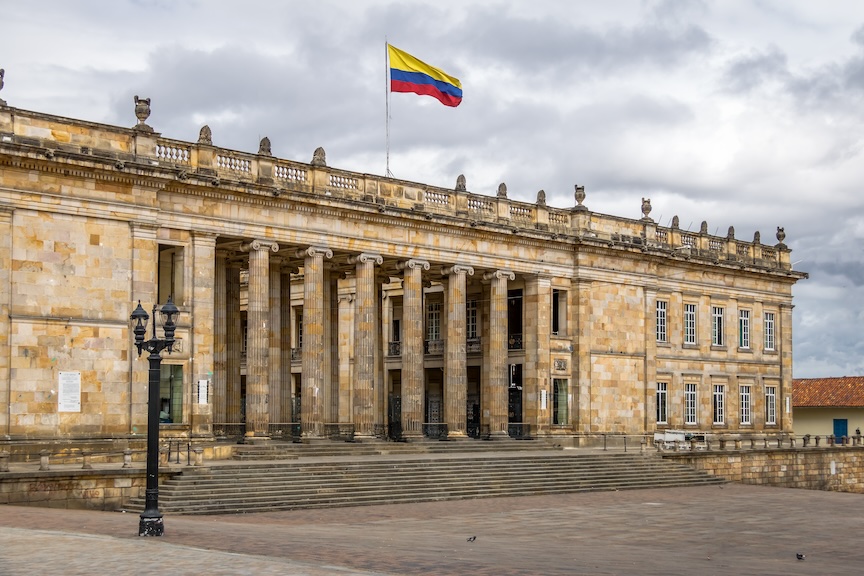
On November 6, 1985 Colombian terrorists of the M-19 group stormed the Palace of Justice in Bogota. There they held two dozen justices, as well as over a hundred other hostages. When the army stormed the building, the M-19 killed all the hostages.
The M-19 (Movimiento 19 de Abril) was a left-wing guerrilla group in Colombia, formed in 1970 as a reaction to what they believed was a fraudulent election that year. The group took its name from the date of that election, April 19. The M-19 aimed to fight against what they perceived as corruption and social injustice in Colombia. Over the years, they gained notoriety for their dramatic and symbolic acts of violence, including the theft of Simón Bolívar’s sword, which they claimed as a symbolic gesture of their revolutionary goals.
By the mid-1980s, Colombia was grappling with intense social and political unrest. The government was embroiled in a battle against various insurgent groups, drug cartels, and paramilitary forces. The M-19, seeking to assert its power and challenge the Colombian government, planned one of its most audacious attacks—the takeover of the Palace of Justice, the very symbol of Colombia’s judicial system.
On the morning of November 6, 1985, 35 armed M-19 guerrillas stormed the Palace of Justice, located in the heart of Bogotá. Disguised as civilians, the guerrillas entered the building, swiftly taking control and seizing around 300 hostages, including nearly two dozen Supreme Court justices. Their primary demand was to force the government of President Belisario Betancur to stand trial for what they viewed as crimes against the Colombian people.
The attack was meticulously planned. The M-19 aimed to use the justices as leverage to push the government into a televised trial and to expose what they believed was the corruption within the state. The group also demanded that the government produce a set of documents known as “the black book,” which allegedly contained evidence of state collusion with paramilitary groups and drug cartels.
The Colombian government, under President Betancur, faced an immense dilemma. The Palace of Justice, located in the Plaza de Bolívar, was a vital institution, and the government could not afford to appear weak in the face of such an attack. However, the lives of the hostages, including some of the country’s most senior judges, were at risk.
After failed attempts to negotiate with the guerrillas, the government decided to take decisive action. On November 7, the Colombian army launched a full-scale assault on the Palace of Justice. Tanks and heavily armed soldiers surrounded the building, and intense fighting ensued. The battle raged for nearly 28 hours, during which the Palace of Justice was severely damaged by gunfire and explosions.
The army’s assault on the Palace of Justice ended in tragedy. As the military stormed the building, the M-19 guerrillas, realizing their situation was hopeless, began executing the hostages. By the time the army regained control of the building, most of the hostages, including 11 Supreme Court justices, were dead. In total, around 100 people were killed, including many hostages, guerrillas, and soldiers. The Palace of Justice was left in ruins, a smoldering reminder of the violent clash that had taken place within its walls.
The aftermath of the siege was marked by controversy and sorrow. Many Colombians were outraged by the government’s handling of the situation, believing that the decision to storm the building had led to unnecessary loss of life. Families of the victims demanded answers, but many aspects of the siege remain shrouded in mystery. There were allegations that some hostages who survived the initial assault were later “disappeared” by security forces, possibly to prevent them from revealing what they had witnessed.
The siege also had significant political repercussions. It exposed the deep divisions within Colombian society and highlighted the brutality of the conflict between the state and insurgent groups. The loss of so many Supreme Court justices was a severe blow to the country’s judicial system, and it took years for the institution to recover.
The Palace of Justice Siege is remembered as one of the darkest moments in Colombia’s history. It was a stark reminder of the human cost of the country’s internal conflict and the fragility of its institutions. The event also left a lasting impact on the Colombian psyche, symbolizing the violence and chaos that plagued the nation during the 1980s and beyond.
In the years following the siege, Colombia continued to struggle with violence and instability, but the memory of the Palace of Justice tragedy served as a catalyst for renewed efforts to achieve peace and justice. The event is commemorated every year, and the rebuilding of the Palace of Justice stands as a testament to the resilience of the Colombian people and their determination to overcome the challenges of their past.
Today, the Palace of Justice Siege serves as a powerful reminder of the dangers of extremism and the importance of protecting democratic institutions. It also underscores the need for accountability and transparency in times of crisis, lessons that continue to resonate in Colombia and around the world.
 >
>